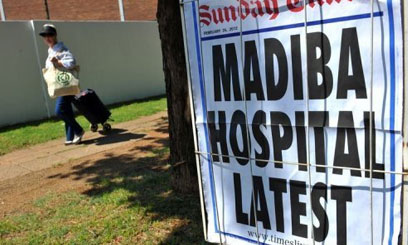Mandela was admitted on Saturday for what President Jacob Zuma’s office called “a long-standing abdominal complaint”, putting the nation on edge over the former president’s health.
“The doctors have decided to send him home as the diagnostic procedure he underwent did not indicate anything seriously wrong with him,” Zuma’s office said in a statement.
Mandela underwent a diagnostic laparoscopy, a procedure in which doctors probe the abdominal area using a tiny camera, to investigate ongoing discomfort.
Shortly before his discharge was announced, Zuma said Mandela, who is known affectionately as Madiba, was relaxed and comfortable after his night’s stay in hospital and was surrounded by his family.
“The doctors have assured us that there is nothing to worry about and that Madiba is in good health,” Zuma said.
Journalists gathered on Sunday afternoon outside Mandela’s Johannesburg home where he returned last month after several months in his childhood village in the Eastern Cape, some 800 kilometres (500 miles) from the country’s economic hub.
Defence Minister Lindiwe Sisulu, whose ministry is charged with Mandela’s health care, earlier said “there never was anything wrong with him” but that the investigative surgery was needed to get to the bottom of his discomfort.
“He’s fine, he is recovering from anaesthetic and he is as fine as can be at his age. He is fine and handsome,” Sisulu reporters in Cape Town.
Norman Mabasa, chairperson of the South African Medical Association, told AFP the procedure involved a “very small puncture hole”.
“You can look inside and magnify that on a screen and as you move your probe you’re able to see the various organs to look at whether they are OK,” he said
“You’re automatically concerned about any illness at that age,” he added.
“That’s why even the smallest itch, you take it seriously, because you don’t want to take things mildly at that age. You want the elderly not to be sick, because once they are sick you get worried about whether that will be the last blow.”
Local TV carried footage of a VIP motorcade leaving One Military hospital in the capital Pretoria shortly before the presidency announced Mandela’s discharge.
Officials have not named the hospital where Mandela was treated and media were kept away from there and another of the hospitals most likely to have treated him, in Johannesburg.
The media generally praised the South African government for handling the episode better than Mandela’s last hospitalisation, for a chest infection, in January 2011.
Then, the government and the Nelson Mandela Foundation kept the media largely in the dark about his treatment, initially described as “routine” testing.
Mandela is beloved in South Africa for leading the country from the dark days of white-minority rule to democracy, and commands huge respect as an international hero.
Rumours over his health flare up periodically, and his public appearances have grown increasingly rare. The last was at the final of the 2010 World Cup in South Africa.
Mandela was released from 27 years in prison in 1990 and was elected South Africa’s first black president four years later. He won the Nobel Peace Prize in 1993 and served one term before stepping down in 1999.









































